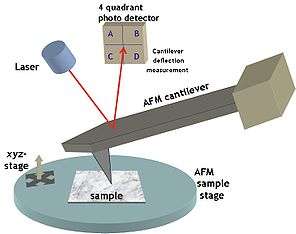Scanning Hall probe microscope
Scanning Hall probe microscope (SHPM) is a variety of a scanning probe microscope which incorporates accurate sample approach and positioning of the scanning tunnelling microscope with a semiconductor Hall sensor. This combination allows to map the magnetic induction associated with a sample. Current state of the art SHPM systems utilize 2D electron gas materials (e.g. GaAs/AlGaAs) to provide high spatial resolution (~300 nm) imaging with high magnetic field sensitivity. Unlike the magnetic force microscope the SHPM provides direct quantitative information on the magnetic state of a material. The SHPM can also image magnetic induction under applied fields up to ~1 tesla and over a wide range of temperatures (millikelvins to 300 K).[1]
The SHPM can be used to image many types of magnetic structures. A few structures are listed below.
- Thin films
- Permanent Magnets.
- MEMS structures.
- Current carrying traces on PCBs
- Permalloy disks
- Recording media
Advantages to other magnetic raster scanning methods
SHPM is a superior magnetic imaging technique due to many reasons including:
- Unlike the MFM technique, the Hall probe exerts negligible force on the underlying magnetic structure and is noninvasive.
- Unlike the magnetic decoration technique, the same area can be scanned over and over again.
- Magnetic field caused by hall probe is so minimal it has a negligible effect on sample it is measuring.
- Sample does not need to be an electrical conductor, unless using STM for height control.
- Measurement can be performed from 5 – 500 K.
- Measurement can be performed in ultra high vacuum (UHV).
- Measurement is nondestructive to the crystal lattice or structure.
- Tests requires no special surface preparation or coating.
- Detectable magnetic field sensitivity, is approximately 0.1 uT – 10 T.
- SHPM can be combined with other scanning methods like STM.
Limitations
There are some shortcomings or difficulties when working with an SHPM, and some of these are as follows:
- High resolution scans become difficult due to the thermal noise of extremely small hall probes.
- There is a minimum scanning height distance due to the construction of the hall probe. (This is especially significant with 2DEG semi-conductor probes due to their multi-layer design).
- Scanning (lift) height affects obtained image.
- Scanning large areas takes a significant amount of time.
- Relatively short practical scanning range (order of 1000's micrometer) along any direction.
- Housing is important to shield electromagnetic noise (Faraday cage), acoustic noise (anti-vibrating tables), air flow (air isolation cupboard), and static charge on the sample (ionizing units).
See also
References
- ↑ Chang, A. M.; Hallen, H. D.; Harriott, L.; Hess, H. F.; Kao, H. L.; Kwo, J.; Miller, R. E.; Wolfe, R.; Van Der Ziel, J.; Chang, T. Y. (1992). "Scanning Hall probe microscopy". Appl. Phys. Lett. 61 (16): 1974. Bibcode:1992ApPhL..61.1974C. doi:10.1063/1.108334.
